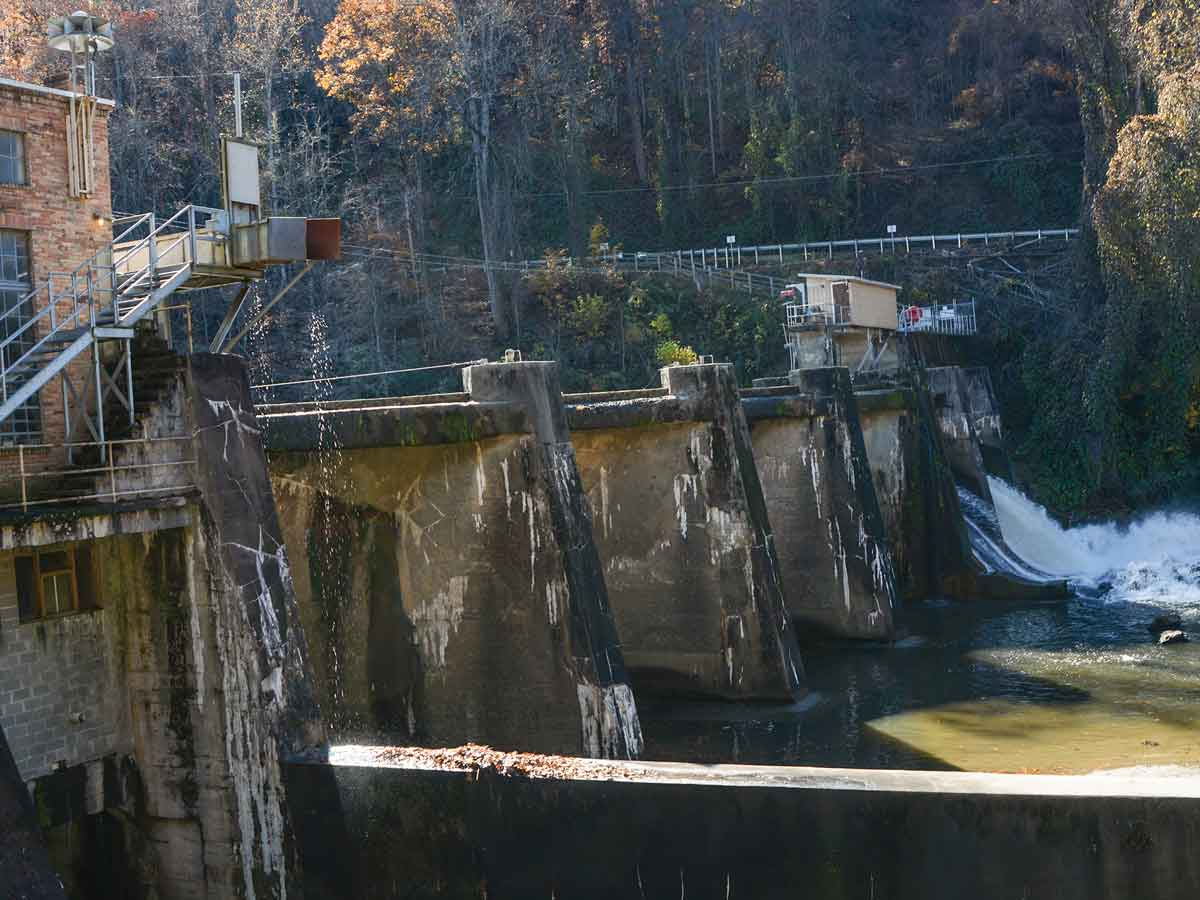Mainspring considers Ela Dam purchase
 Ela Dam has been in operation since 1925. File photo
Ela Dam has been in operation since 1925. File photo
Franklin-based nonprofit Mainspring Conservation Trust will take the lead in efforts to remove 97-year-old Ela Dam if its board decides in favor of acquiring the 62-acre property now owned by Northbrook Hydro II.
“It really checks a lot of boxes in terms of our mission,” said Jordan Smith , Mainspring’s executive director. “At the end of the day, we’ve never led a huge dam removal project, so that’s a little bit intimidating for an organization of our size. Some really serious discussions are happening at the board level as to whether or not we want to continue down the path.”
The coalition behind the dam removal effort had originally envisioned the Eastern Band of Cherokee Indians as the end property owner, and in February the Tribal Council unanimously approved a resolution to lead removal efforts . In May, the Timber Committee voted — also unanimously — to recommend that Council approve a resolution committing the tribe to pursue acquiring the property. But when the legislation came before Tribal Council June 2, five of the 12 members voted against it and one walked out prior to the vote. The vote failed.
“Although stunned by the Tribal Council’s action, the coalition immediately reaffirmed its commitment to aggressively pursuing removal of the Bryson Project,” reads a June 10 email from Chuck Ahlrichs — president of dam operator Northbrook Power Management — to Andrew Moore, an environmental specialist with the N.C. Department of Environmental Quality. “In a June 7th call with NCHII (Northbrook Carolina Hydro II), Mainspring Conservation Trust agreed to consider stepping into EBCI’s role as the acquirer of the Bryson Project, and to continue working with American Rivers and SELC (Southern Environmental Law Center) to raise demolition funding.”
Weighing the options
The coalition, which includes Northbrook along with nonprofits, governments and government agencies, began discussing dam removal after a massive sediment release in October 2021 blanketed the downstream river. In evaluations afterwards, state and federal wildlife agencies said the deposits, in places more than a foot deep, were likely devastating to the aquatic communities living there.
The release was accidental and the result of a “faulty, legacy computer code,” said Northbrook Power Management Vice President Chris Sinclair, adding that prior to October 2021 the company had continuously operated dams in the Carolinas without incident for more than a quarter-century. In a Dec. 27, 2021, document sent to the Federal Energy Regulatory Commission, Ahlrichs said the company was drawing down the dam to evaluate a breach in one of the stoplogs used to control water flow when the programming malfunction occurred. Since then, the company has engaged an IT consultant to find the faulty code, hired a contractor to remove the sediment, engaged a nationally recognized river restoration consultant, and participated in bi-weekly meetings with the dam removal coalition for the past seven months.
Related Items
Put into operation in 1925, the dam is small, old, and produces very little energy, netting Northbrook only about $55,300 annually. Coalition members say that removing it would have a negligible impact on the area’s energy supply but a large impact on ecosystem health and recreation opportunities.
“We want to be good partners and we want the project to be a success, and we realize that at this juncture the ball is squarely in our court, because there really are no other partners in that coalition that are at the table other than the tribe that can move the project forward on the timeline that’s it’s on,” said Smith.
While it’s an important project, it’s also a big project, and it wasn’t part of Mainspring’s budget or work plan at the beginning of the year. Smith and his board are thinking about how best to use their donors’ money and about how to weigh the risk involved with assuming ownership of a 97-year-old dam.
Mainspring has retained California-based Water and Power Law Group , whose partners have a combined 50 years of experience in dam removal projects, to help it review the purchase agreement, Smith said. He expects his board will make a decision sometime next month.
According to an Aug. 5 email Sinclair sent to Moore and David Brown, a regulatory specialist for the U.S. Army Corps of Engineers, the draft purchase agreement was in an “advanced stage of negotiation,” with Mainspring’s counsel reviewing the title, permits and environmental reports. Northbrook contributed $10,000 toward the cost of legal review and consultations. If Mainspring decides to move forward, the email said, it will hold an option to acquire the dam while American Rivers will oversee “the bulk of the work” in pursuing funding for feasibility studies and demolition.
“At the most recent Bryson Coalition meeting on Aug. 2, American Rivers indicated that it was confident it would be able to procure funding for the feasibility engineering study to remove the Bryson Project from the N.C. Wildlife Resources Commission,” the email said. “It also expressed confidence in obtaining funding for ultimate impoundment removal assuming the feasibility study did not present unexpected roadblocks … At the same Bryson Coalition meeting of Aug. 2, Joey Owle of the Eastern Band of Cherokee Indians indicated that the tribe counsel (sic) had agreed to accept grant funds that could be used towards feasibility studies and Mainspring expenses. Mr. Owle also presented a letter of support from the EBCI Principal Chief’s Office.”
Sediment cleanup complete
Tribal Council’s June 2 vote against purchasing the dam had the potential to end removal efforts. After the sediment dump, Northbrook received violation notices from DEQ and the Army Corps of Engineers that required it to clean up the mess. The work started in December but halted in March to avoid disturbing sicklefin redhorse spawning season. It was slated to resume June 15 if no solid dam removal plan were in place.
In his June 10 email to DEQ’s Moore, Ahlrichs wrote that the change in dam removal partners would delay executing the needed documents and asked that the agency extend its suspension of sediment removal requirements.
“A key element in the negotiated terms of an agreement is the elimination of further remediation and future mitigation associated with the inadvertent sediment release, to ensure all available funds can be committed to a dam removal effort,” Ahlrichs wrote. “Further justification for the continued suspension of sediment removal activities is the current good condition of the river resulting from NCHII’s removal activities and the river’s own cleansing actions.”
Spring brought an “active” fish spawning, Sinclair said, and a third-party review showed that the river had been restored. A July 13 report from Inter-Fluve Inc, the sediment removal company, showed sediment accumulation levels at 3.5% of the volume observed in the initial survey conducted Dec. 16, 2021.
“Any negative impacts to the habitat appear to have been temporary, as active spawning aggregations of Tennessee shiner on chub species nests were observed during the site visit, as well as accounts of observations of sicklefin redhorse, brown trout and other fish species from local residents,” the report concluded. “The reduced quantity of sediment that remains in the reach is typical for streams of this nature in the area and will continue to mobilize and re-deposit during periodic high flow events.”
In an Aug. 9 letter to Ahlrichs, Moore wrote that DEQ now considered the violation closed. Northbrook would not have to spend additional funds removing sediment — giving the coalition more time to explore options for removal.
“Over our 25-year history as an organization, we would have done zero conservation work if we didn’t have great landowners to work with,” said Smith. “In this case, Northbrook is the landowner and they’re a great partner and a willing partner, and you have to have that to make a good project. So it’s just a matter of making some decisions at this point.”









